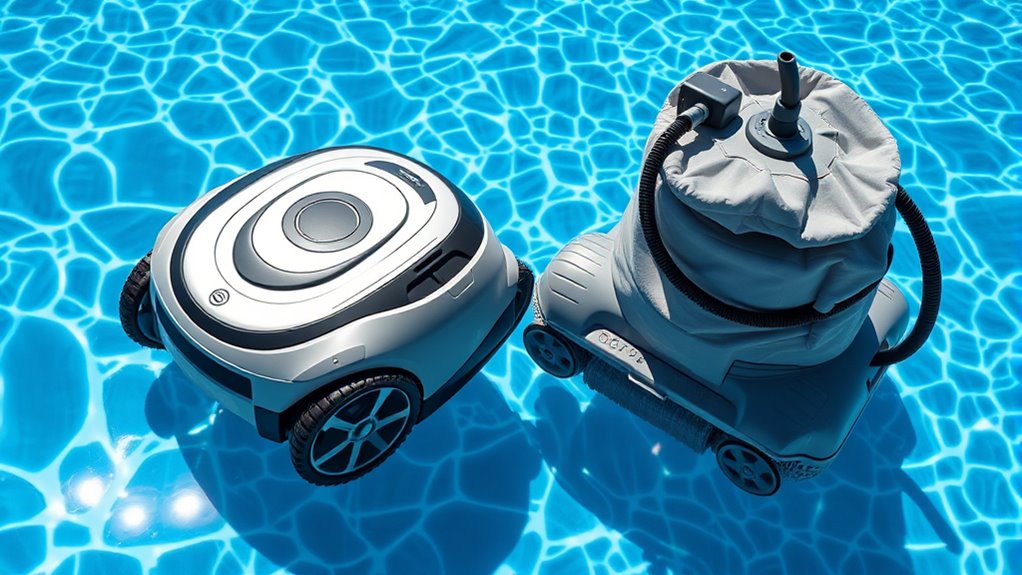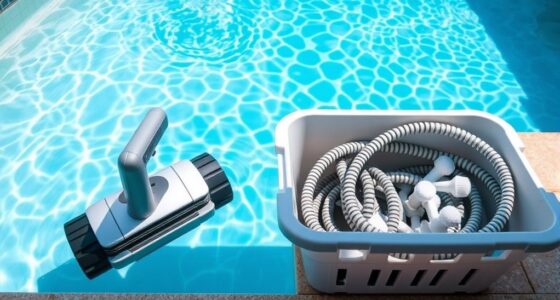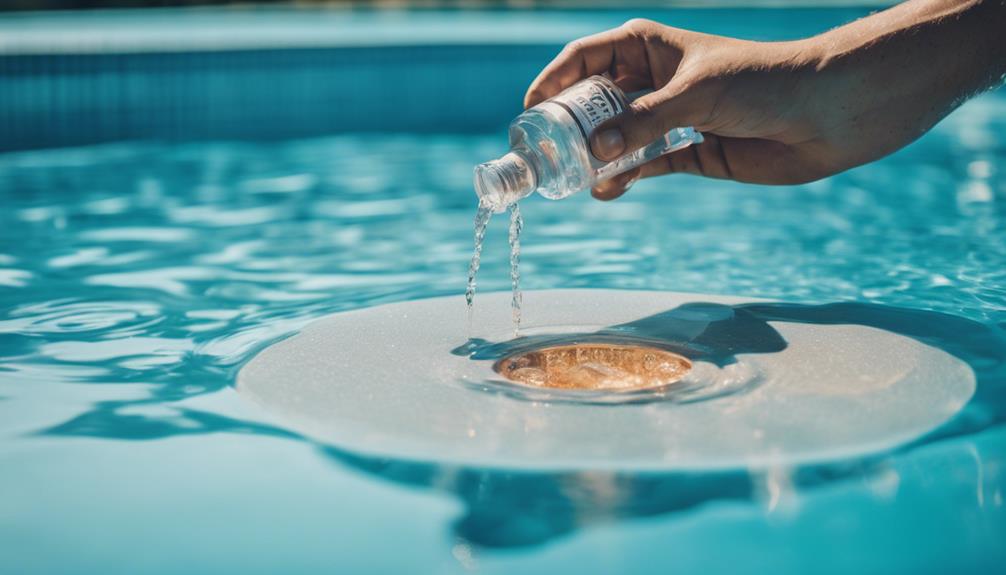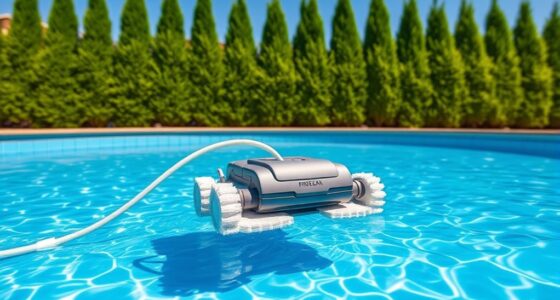Robotic pool cleaners are easy to use, energy-efficient, and great for complex pools, but they come with higher upfront costs. Suction cleaners are budget-friendly, simple to set up, and work well in small, straightforward pools, though they may require more manual effort and energy. If you want a low-maintenance, tech-savvy option, robotic cleaners excel. For basic needs or tight budgets, suction cleaners may suffice. Continue to explore the details to find the best fit for your pool.
Key Takeaways
- Robotic cleaners offer advanced navigation, targeting hard-to-reach spots, while suction cleaners are simpler and better for basic debris removal.
- Robotic units have higher upfront costs but lower long-term energy and maintenance expenses compared to suction cleaners.
- Suction cleaners are more affordable initially and easier to set up but may require more manual effort and maintenance.
- Robotic cleaners excel in complex, large, or irregularly shaped pools, whereas suction cleaners are suitable for small or straightforward pools.
- Robotic models provide customizable cleaning cycles and app control, offering greater convenience and efficiency over manual suction systems.
Ease of Use and Maintenance

When choosing between robotic and suction pool cleaners, ease of use and maintenance are key factors to contemplate. If you prefer straightforward operation, a robotic cleaner with a user interface designed for simplicity can make a big difference. Many models come with remote control options, allowing you to start, stop, or schedule cleaning sessions from afar. This convenience minimizes the effort needed to keep your pool spotless. Additionally, consider how easy it is to access and clean filters or brushes—some robotic models feature quick-release mechanisms that save time. Robotic cleaners often incorporate user-friendly controls, which can significantly enhance the overall experience. Suction cleaners tend to be more straightforward but may require more manual intervention. Overall, a user-friendly interface and remote control options can streamline maintenance, making pool cleaning less of a chore. Moreover, integrating AI technology into robotic cleaners can enhance their efficiency and effectiveness, providing smarter cleaning patterns and better coverage. Regularly checking filter accessibility and following manufacturer guidelines can further simplify upkeep and ensure optimal performance. Proper maintenance of technological features also helps extend the lifespan of your cleaner and maintains its cleaning quality. Additionally, selecting a model with intuitive controls can reduce the learning curve and make operation even easier for users of all experience levels.
Cleaning Performance and Effectiveness
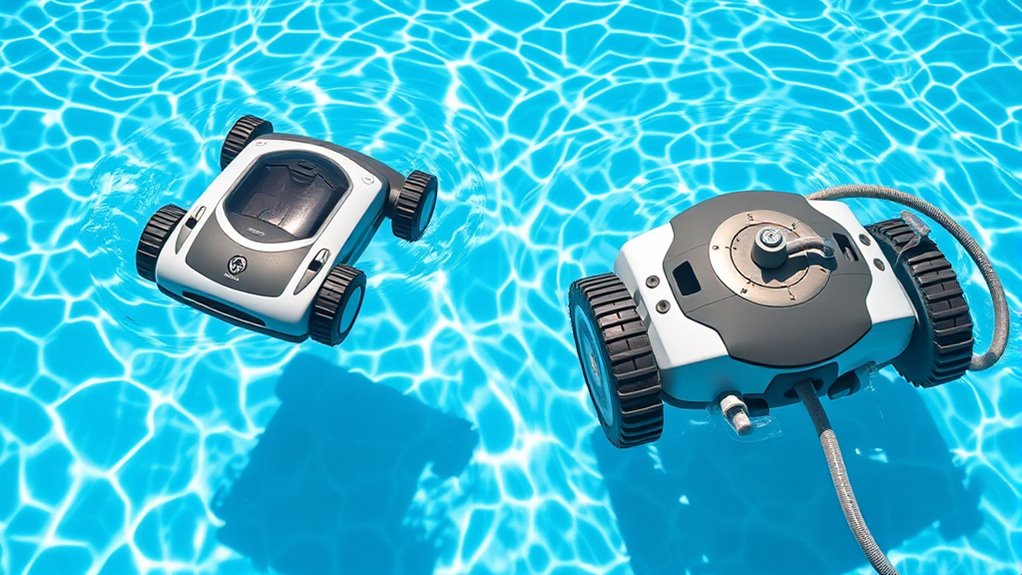
Robotic pool cleaners generally deliver superior cleaning performance compared to suction models, thanks to their advanced navigation and targeted scrubbing capabilities. They move efficiently across the pool floor and walls, maintaining a consistent cleaning speed that ensures thorough debris removal. Unlike suction cleaners that often miss spots or struggle with complex shapes, robotic models adapt to your pool’s layout, reaching corners and tight spots more effectively. Their precision allows for better removal of dirt, algae, and small debris, leaving your pool cleaner and clearer. Additionally, robotic cleaners often come with specialized brushes or scrubbers that enhance their cleaning effectiveness, especially on stubborn stains or algae buildup. Their intelligent navigation and focused cleaning lead to a more exhaustive and faster cleaning process. Furthermore, many robotic pool cleaners feature programmable settings and app controls, allowing users to customize cleaning cycles for even more efficient maintenance. Incorporating advanced technology in their design, these cleaners can often detect the size and types of debris, optimizing the cleaning pattern accordingly. Moreover, some models include filtering systems designed to trap finer particles, ensuring a more comprehensive cleaning. Staying updated with machine learning algorithms can further improve their adaptability and cleaning efficiency over time. Additionally, the integration of sensor technology helps robotic cleaners detect obstacles and adjust their path to prevent collisions or missed areas.
Energy Efficiency and Power Consumption
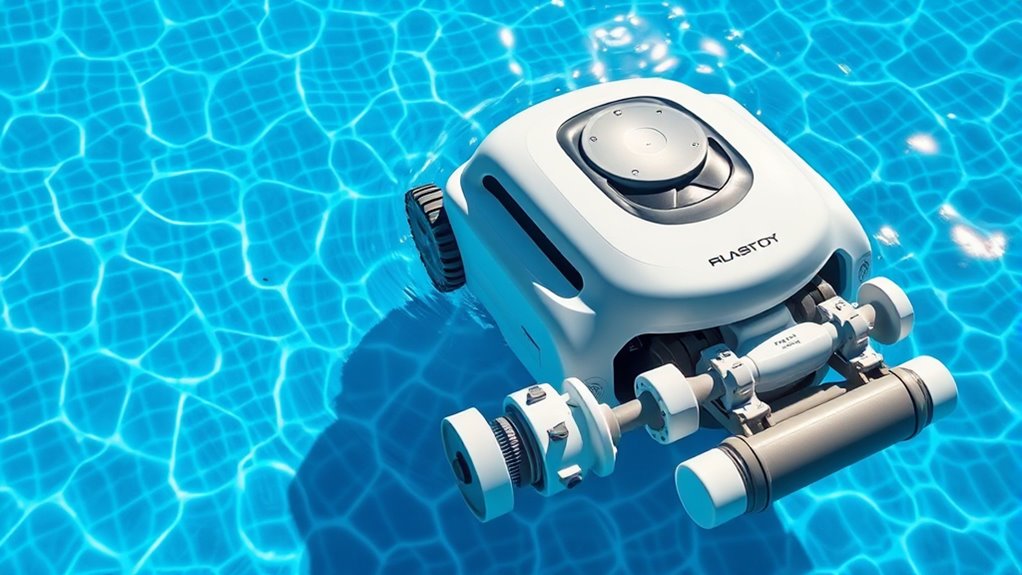
Robotic pool cleaners are often more energy-efficient than suction models because they are designed to operate using less power while maintaining effective cleaning performance. Their advanced technology allows for optimized movement and cleaning cycles, reducing unnecessary energy use. This focus on power efficiency means you’ll see lower electricity bills over time. Additionally, robotic cleaners typically have a longer battery lifespan since they rely on batteries that are built for energy conservation. This durability ensures you don’t need frequent replacements, saving you money and reducing waste. Moreover, their advanced navigation systems enable them to cover pools more thoroughly without wasting energy on redundant paths. These systems often incorporate smart sensors that adapt cleaning patterns based on pool size and shape, further enhancing efficiency. Overall, if energy efficiency and low power consumption matter to you, robotic cleaners stand out by providing thorough cleaning without draining your power supply. Their smarter design benefits both your wallet and the environment.
Cost and Budget Considerations
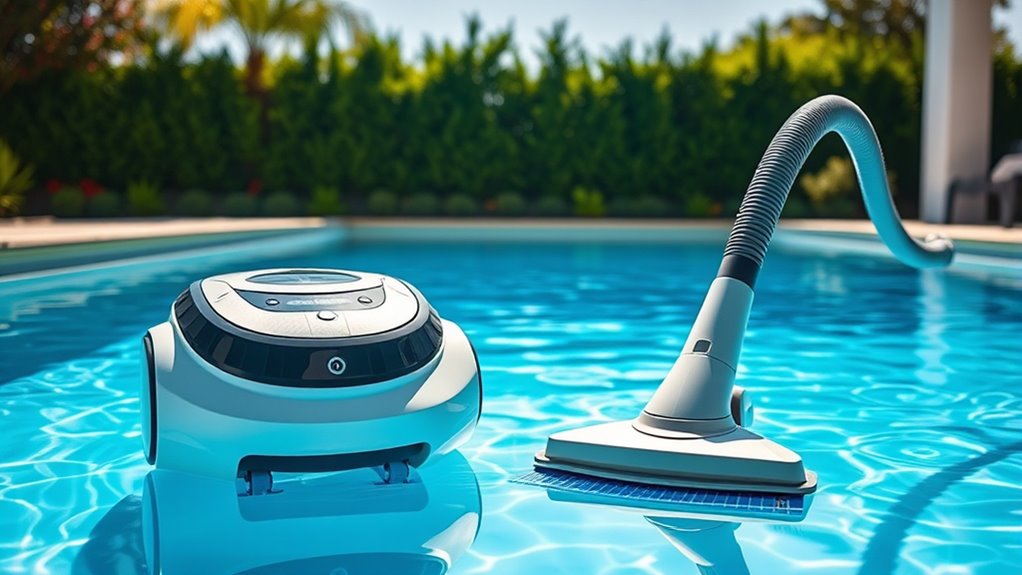
When choosing between robotic and suction pool cleaners, you need to contemplate both the initial purchase price and the ongoing maintenance costs. Robotic cleaners often come with a higher upfront price but may save you money over time through lower maintenance expenses. Balancing these costs will help you select a cleaner that fits your budget and long-term needs. Additionally, considering the potential pitfalls in adopting new payment technologies can be helpful if managing these decisions causes stress or anxiety. Understanding the benefits of airless paint sprayers, such as their time efficiency and superior finish, can also influence your overall investment approach. Exploring how sound healing science utilizes specific frequencies for health benefits may inspire innovative ways to enhance your pool area’s relaxation environment. Moreover, evaluating the long-term durability of different cleaners can ensure you choose a device that remains effective and reliable over years of use.
Purchase Price Differences
Suction pool cleaners generally come with a lower purchase price compared to robotic models, making them an attractive option for budget-conscious homeowners. When considering a pricing comparison, suction cleaners typically have a more affordable initial investment. Robotic cleaners, with advanced features and automation, usually cost considerably more upfront. If you’re prioritizing cost savings, a suction cleaner offers a straightforward, budget-friendly solution. The initial investment for a suction model is often half or less than that of a robotic device, making it easier to fit into your pool maintenance budget. Additionally, suction cleaners may require less maintenance and filter replacements, further reducing ongoing costs. They also tend to have simpler designs and technology, which can contribute to easier repairs and less frequent replacements. It’s also worth noting that some models are compatible with smart home integrations, which can add to their convenience and value. While robotic cleaners may justify their higher price with added convenience and technology, suction cleaners are ideal if you want an effective cleaning tool without a large upfront expense.
Long-term Maintenance Expenses
Long-term maintenance expenses can especially impact the overall cost of your pool cleaning system. Robotic cleaners often require filter replacement, which can add up over time as filters need regular cleaning or replacement to maintain efficiency. Additionally, their motors may occasionally need repair or replacement, especially with frequent use. Suction pool cleaners tend to have lower maintenance costs initially but can also require motor repairs if the suction motor wears out. While robotic cleaners might have higher upfront costs, their durability and ease of maintenance can save you money long-term. Conversely, suction cleaners typically have fewer parts that need replacement, but repairs can become costly if the motor fails. Considering these ongoing expenses helps you choose a system that fits your budget over the lifespan of your pool cleaner.
Installation and Setup Process
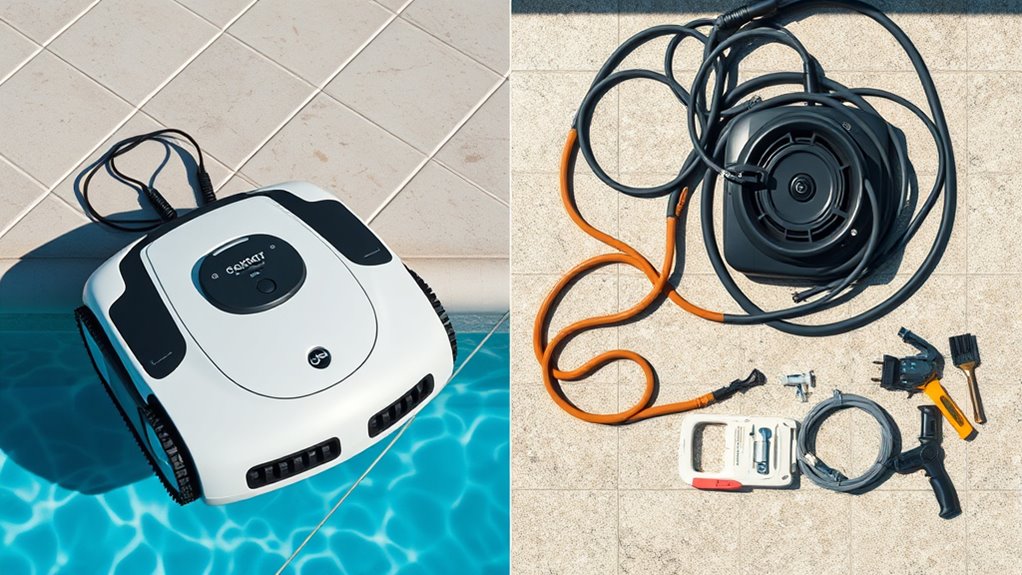
Setting up your pool cleaner isn’t complicated, but the process varies between robotic and suction models. Some are ready to go out of the box, while others require more assembly or connection to your pool’s filtration system. Understanding the ease or complexity of installation helps you choose the right option for your needs.
Ease of Installation
When it comes to installing robotic and suction pool cleaners, the process can vary considerably in complexity. Robotic cleaners often require a straightforward setup with minimal manual operation; you simply place the unit in the pool, connect it to power, and use the user interface to select cleaning modes. They typically come with clear instructions and easy-to-use controls, making initial installation quick and hassle-free. Suction cleaners, on the other hand, may involve more steps, such as attaching hoses and securing fittings, which can be a bit more manual. While both types generally don’t demand professional help, robotic cleaners tend to be more user-friendly in terms of setup, especially for beginners. Overall, robotic cleaners usually offer a smoother, less labor-intensive installation experience.
Setup Complexity
Robotic cleaners are generally simpler to set up compared to suction models, thanks to their streamlined process. With robotic cleaners, you often just need to place them in the pool, connect the charger, and activate automatic programming. In contrast, suction models may require manual setup, such as attaching hoses, adjusting skimmers, or configuring pump settings.
Here’s what sets robotic cleaners apart:
- Minimal manual setup—plug and play.
- Automatic programming allows you to schedule cleanings easily.
- Fewer components to assemble or adjust before use.
This simplicity makes robotic cleaners more user-friendly, saving you time and effort during setup. Suction models, while effective, often demand more manual effort to configure and get running.
Durability and Longevity

Robotic and suction pool cleaners are built to withstand regular exposure to water and debris, but their durability varies based on design and quality. High material quality ensures they can resist wear and tear over time, extending their lifespan. Corrosion resistance is particularly important, as constant contact with chemicals and moisture can cause metal parts to degrade. Robotic cleaners often feature durable plastics and sealed components, making them more resistant to corrosion. Suction cleaners, depending on their build, may be more susceptible to corrosion if made with lower-quality materials. Regular maintenance and choosing models with superior material quality can considerably boost longevity. Ultimately, investing in a well-constructed cleaner means fewer replacements and more dependable performance season after season.
Suitability for Different Pool Types

Choosing the right pool cleaner depends heavily on your pool’s type and environment. For larger pools, robotic cleaners often cover more ground efficiently, making them ideal for extensive spaces. Suction cleaners work well in small to medium pools, especially when debris is primarily dirt and leaves. Consider these points:
- Pool size: Robotic cleaners excel in big pools, while suction models suit smaller ones.
- Debris type: Suction cleaners handle lightweight debris like leaves better; robotic cleaners are better for mixed debris.
- Pool shape and features: Pools with complex shapes or steps may benefit more from robotic cleaners with adaptable movement.
Matching your pool’s size and debris type ensures excellent cleaning performance and longevity of your equipment.
Technological Features and Automation
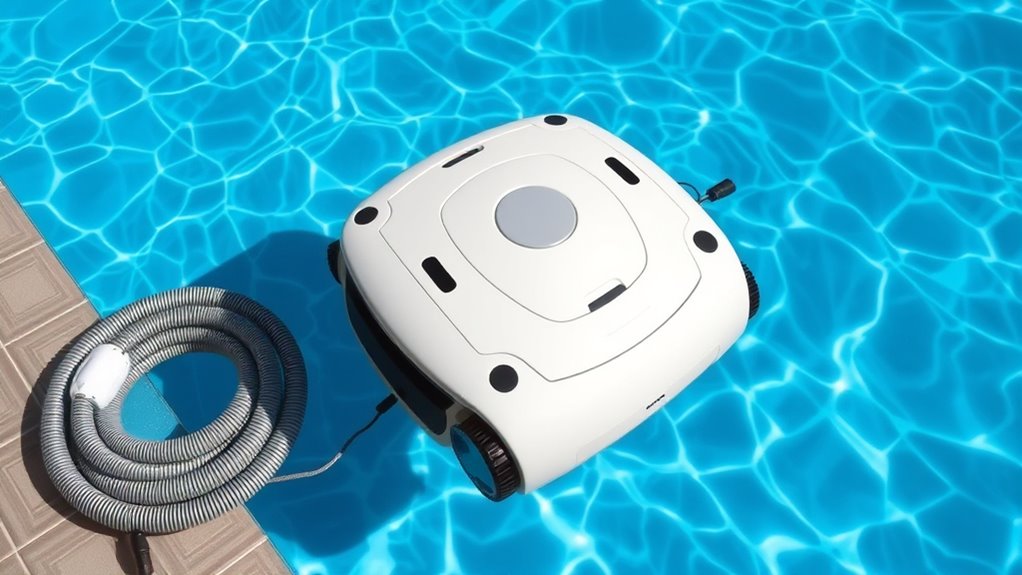
Advancements in technology have considerably enhanced the capabilities of pool cleaners, making automation more accessible and efficient. Modern robotic cleaners often feature AI integration, allowing them to adapt to your pool’s layout and cleaning needs intelligently. Sensor technology plays a pivotal role, helping these devices detect dirt, obstacles, and water levels, ensuring thorough cleaning with minimal supervision. Some models even map your pool’s shape for optimized navigation, reducing missed spots. Suction pool cleaners, while less advanced in automation, benefit from smart features like adjustable suction power and automatic shutoff. Overall, these technological features streamline the cleaning process, save you time, and improve performance. Whether you prefer the advanced automation of robotic cleaners or the simplicity of suction models, technological innovations continue to elevate both options.
Frequently Asked Questions
Which Type Is Better for Above-Ground Pools?
For above-ground pools, your choice depends on pool size and cleaning efficiency. If your pool is small, a suction pool cleaner offers simple, effective cleaning without much effort. For larger pools, a robotic cleaner provides better cleaning efficiency, covering more surface area quickly. Consider your pool size and how thoroughly you want it cleaned. Robotic cleaners tend to be more versatile, but suction models can be sufficient for basic maintenance.
How Often Should I Replace Parts on Each Cleaner?
Oh, the joy of maintenance! You should follow the recommended maintenance schedule for each cleaner, but don’t be shocked if parts need replacement more often than you’d like. Typically, robotic cleaner brushes last about six months, while filters may need changing every year. Suction cleaners usually require belt replacements every year and hose checks every few months. Stay proactive, and your pool will stay pristine—just don’t forget to keep up with the replacement frequency!
Are Robotic Cleaners Suitable for Very Deep Pools?
If you have a very deep pool, robotic cleaners might not be the best choice for pool maintenance. They are designed mainly for standard depths and may struggle to reach the bottom effectively, diminishing cleaning efficiency. For deep pools, consider suction cleaners or pressure-side models, as they tend to perform better in maintaining cleanliness at greater depths. Always check your cleaner’s specifications to verify it suits your pool’s depth and size.
Can These Cleaners Handle Algae and Stubborn Debris?
You might wonder if these cleaners can handle algae removal and stubborn debris. While robotic and suction pool cleaners excel at debris handling, their effectiveness with algae depends on the model and features. Some robotic cleaners have specialized brushes and filters for algae removal, making them more suitable for stubborn debris. Regular maintenance and pre-treatment with pool chemicals also help improve their cleaning performance on algae and tough debris.
Do They Require Wi-Fi or App Control for Operation?
Did you know nearly 80% of modern pool cleaners offer Wi-Fi connectivity or app control? You don’t need to be tech-savvy to operate them; just connect your device, and you’re set. These features allow you to start, schedule, or monitor cleaning remotely, making maintenance easier. So, if you prefer convenience, choose a cleaner with app control or Wi-Fi connectivity—no manual operation required.
Conclusion
Choosing between robotic and suction pool cleaners is like selecting the perfect dance partner—each has its rhythm and charm. Robotic cleaners glide gracefully with advanced tech, while suction models rely on the pool’s own energy to do the heavy lifting. Decide what fits your dance style, budget, and pool type. Whichever you pick, you’ll be turning your pool into a shimmering oasis, sparkling like a jewel, ready for your next splash adventure.

